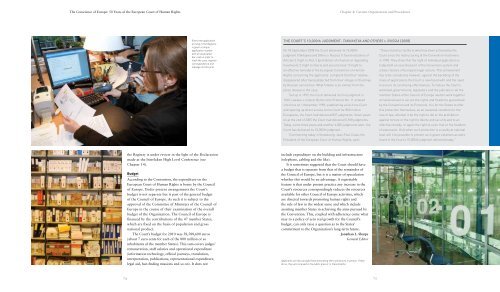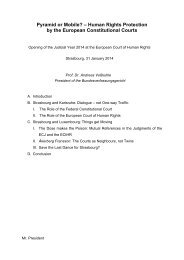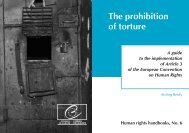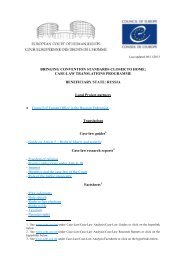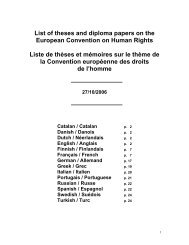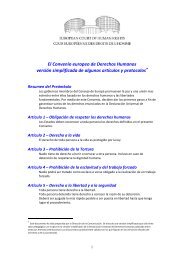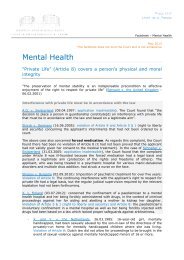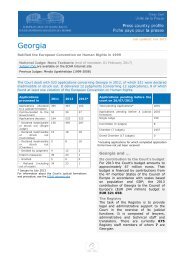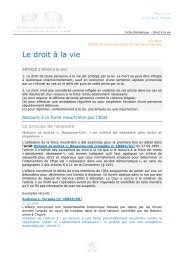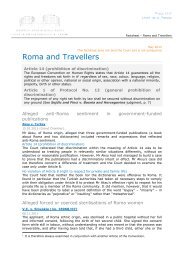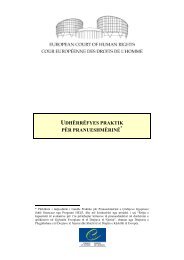The Conscience of Europe - European Court of Human Rights ...
The Conscience of Europe - European Court of Human Rights ...
The Conscience of Europe - European Court of Human Rights ...
Create successful ePaper yourself
Turn your PDF publications into a flip-book with our unique Google optimized e-Paper software.
<strong>The</strong> <strong>Conscience</strong> <strong>of</strong> <strong>Europe</strong>: 50 Years <strong>of</strong> the <strong>Europe</strong>an <strong>Court</strong> <strong>of</strong> <strong>Human</strong> <strong>Rights</strong><br />
74<br />
Every new application<br />
arriving in the Registry<br />
is given a unique<br />
application number<br />
with an associated<br />
bar-code in order to<br />
track the case, register<br />
correspondence and<br />
manage its life cycle.<br />
the Registry is under review in the light <strong>of</strong> the Declaration<br />
made at the Interlaken High Level Conference (see<br />
Chapter 14).<br />
Budget<br />
According to the Convention, the expenditure on the<br />
<strong>Europe</strong>an <strong>Court</strong> <strong>of</strong> <strong>Human</strong> <strong>Rights</strong> is borne by the Council<br />
<strong>of</strong> <strong>Europe</strong>. Under present arrangements the <strong>Court</strong>’s<br />
budget is not separate but is part <strong>of</strong> the general budget<br />
<strong>of</strong> the Council <strong>of</strong> <strong>Europe</strong>. As such it is subject to the<br />
approval <strong>of</strong> the Committee <strong>of</strong> Ministers <strong>of</strong> the Council <strong>of</strong><br />
<strong>Europe</strong> in the course <strong>of</strong> their examination <strong>of</strong> the overall<br />
budget <strong>of</strong> the Organization. <strong>The</strong> Council <strong>of</strong> <strong>Europe</strong> is<br />
financed by the contributions <strong>of</strong> the 47 member States,<br />
which are fixed on the basis <strong>of</strong> population and gross<br />
national product.<br />
<strong>The</strong> <strong>Court</strong>’s budget for 2010 was 58,588,600 euros<br />
(about 7 euro cents for each <strong>of</strong> the 800 million or so<br />
inhabitants <strong>of</strong> the member States). This sum covers judges’<br />
remuneration, staff salaries and operational expenditure<br />
(information technology, <strong>of</strong>ficial journeys, translation,<br />
interpretation, publications, representational expenditure,<br />
legal aid, fact-finding missions and so on). It does not<br />
On 18 September 2008 the <strong>Court</strong> delivered its 10,000th<br />
judgment (Takhayeva and Others v. Russia). It found violations <strong>of</strong><br />
Articles 2 (right to life), 3 (prohibition <strong>of</strong> inhuman or degrading<br />
treatment), 5 (right to liberty and security) and 13 (right to<br />
an effective remedy) <strong>of</strong> the <strong>Europe</strong>an Convention on <strong>Human</strong><br />
<strong>Rights</strong> concerning the applicants’ complaint that their relative<br />
disappeared after being abducted from their village in Chechnya<br />
by Russian servicemen. What follows is an extract from the<br />
press release in the case.<br />
‘Set up in 1959, the <strong>Court</strong> delivered its first judgment in<br />
1960, Lawless v. Ireland. By the time Protocol No. 11 entered<br />
into force on 1 November 1998, establishing a full-time <strong>Court</strong><br />
and opening up direct access to the <strong>Court</strong> for 800 million<br />
<strong>Europe</strong>ans, the <strong>Court</strong> had delivered 837 judgments. Seven years<br />
on at the end <strong>of</strong> 2005 the <strong>Court</strong> had delivered 5,968 judgments.<br />
Today, some three years and another 4,000 judgments later, the<br />
<strong>Court</strong> has delivered its 10,000th judgment.<br />
‘Commenting today in Strasbourg, Jean-Paul Costa, the<br />
President <strong>of</strong> the <strong>Europe</strong>an <strong>Court</strong> <strong>of</strong> <strong>Human</strong> <strong>Rights</strong>, said:<br />
include expenditure on the building and infrastructure<br />
(telephone, cabling and the like).<br />
It is sometimes suggested that the <strong>Court</strong> should have<br />
a budget that is separate from that <strong>of</strong> the remainder <strong>of</strong><br />
the Council <strong>of</strong> <strong>Europe</strong>, but it is a matter <strong>of</strong> speculation<br />
whether this would be an advantage. A regrettable<br />
feature is that under present practice any increase in the<br />
<strong>Court</strong>’s resources correspondingly reduces the resources<br />
available for other Council <strong>of</strong> <strong>Europe</strong> activities, which<br />
are directed towards promoting human rights and<br />
the rule <strong>of</strong> law in the widest sense and which include<br />
assisting member States in achieving the aims pursued by<br />
the Convention. This, coupled with adherence come what<br />
may to a policy <strong>of</strong> zero real growth for the Council’s<br />
budget, can only raise a question as to the States’<br />
commitment to the Organization’s long-term future.<br />
Jonathan L. Sharpe<br />
General Editor<br />
Applicants are discouraged from presenting their grievances in person. If they<br />
do so, they are received in the public area or in these booths.<br />
Chapter 4: Current Organization and Procedures<br />
ThE CourT’s 10,000th JuDgmEnT: TAkHAyevA And OTHerS v. ruSSiA (2008)<br />
75<br />
“<strong>The</strong>se statistics testify to what has been achieved by the<br />
<strong>Court</strong> since the restructuring <strong>of</strong> the Convention machinery<br />
in 1998. <strong>The</strong>y show that the right <strong>of</strong> individual application is<br />
today both an essential part <strong>of</strong> the Convention system and<br />
a basic feature <strong>of</strong> <strong>Europe</strong>an legal culture. This achievement<br />
has to be considered, however, against the backdrop <strong>of</strong> the<br />
mass <strong>of</strong> applications the <strong>Court</strong> is now faced with and the need<br />
to ensure its continuing effectiveness. To reduce the <strong>Court</strong>’s<br />
workload, governments, legislators and the judiciary in all the<br />
member States <strong>of</strong> the Council <strong>of</strong> <strong>Europe</strong> need to work together<br />
at national level to secure the rights and freedoms guaranteed<br />
by the Convention and its Protocols. It is for the States to <strong>of</strong>fer<br />
this protection themselves, as an essential condition for the<br />
rule <strong>of</strong> law, whether it be the right to life or the prohibition<br />
against torture or the right to liberty and security and to an<br />
effective remedy, or again the right to a fair trial or the freedom<br />
<strong>of</strong> expression. Only when such protection is a reality at national<br />
level will it be possible to prevent such grave violations as were<br />
found in the <strong>Court</strong>’s 10,000th judgment delivered today.”’


